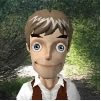Out of sequence here for a bit, but these next few albums are likely considered aberrations from the canon. The Christmas album is probably the one Fahey album most people have heard, and what a revelation at the time. Christmas music was usually the height of schmaltz when this LP came out, so how refreshing to hear traditional Christmas tunes and carols (nary a Frosty or a Rudolph to be heard) performed simply on guitar. Nowadays you can't shake a candy cane without smacking up against a Solo Piano Christmas, or flute or mandolin or dulcimer....you get the idea. My favorite track is "What Child Is This?", with a little reverb to get that extra-chilly moon-shining-on-freshly-fallen-snow vibe. The CD contains both the original LP plus a good chunk of the "Christmas with John Fahey II" LP, both including some of the longer pieces that bored most of my friends and family then and now.
So, then the contract with the Big Record Company. "Of Rivers and Religion" and "After the Ball" were on Warner Brothers, and as much as I like them, they're generally considered John's major flops. "Rivers" fared better -- only a few tracks featured extra musicians, and it includes the classic "Steamboat Gwine Round de Bend", which John dismissed later as a 'series of cliches' (we'll overlook the politically-incorrect title).
The Dixieland touches aren't garish, but they are more prominent in "After the Ball", whose cover I'll spare you (imagine Fonzie bringing Mrs C to the prom...it's THAT BAD.) I remember picking the LP up at the Cellophane Square store in Seattle's U District, and it was a white label promo copy (that alone should have tipped me off that maybe this wasn't primo Fahey). But it was one of the first Fahey albums I ever owned, so I wasn't aware that he didn't normally perform with members of Andy Williams' back-up band. But still, "Horses" and "Beverly" are great songs, and the "Spanish Two-Step" update "Hawaiian Two-Step" (with ukuleles!) is delightful. They've been reissued on Collector's Choice, not my favorite label, but what are you gonna do if nobody else will put 'em back out?
"Fare Forward Voyagers (Soldier's Choice)" was John returning to Takoma, licking his wounds, I imagine. It consists of 3 longer pieces, and it reminds me of what John sounded like live. I don't know if he was playing a medley or what, I just remember this torrent of sound pouring from his guitar. I'm still getting used to the first 2 tracks, but the 3rd (the title track) I liked from the first. According to reviewers, John's style was beginning to adapt Indian music, and as much Indian music as I've listened to over the years, I just don't hear it in John's playing. Maybe reviewers were struggling to find comparisons, and the longer raga form seemed appropriate. It took me a while to place some of the "strangled" notes -- I hardly recognized "Amazing Grace" on "America" -- but now I hear echoes of Irish pipe music, which always sounded to me like someone choking an oboe.
.
Finally, I picked up "The Best of John Fahey Vol. 2", and it's a good package, mainly because there are several rare or unreleased tracks included, and there's a good chunk from "Railroad", one of the last albums before John went headlong into noise and 'alternative' guitar. Then came the ravages of Epstein-Barr syndrome, diabetes, divorce, drink...well, I prefer to remember the earlier days. John passed away in 2001 after a sextuple-bypass operation. He always went his own way, and in that sense, I like to think of him as the Neil Young of acoustic guitar. Long may he wave.





























 Summer's here and the time is right for waxing down our surfboards. I guess... Never ever surfed, but I did own a pair of baggies once! Still, I listen to way more surf music than my wife can stand. Best overall collection is the "Cowabunga" box set, from which I burned off a sampling, from "Mr. Moto" by the Belairs to more contemporary tracks like "Killer Dana" by the Chantays and the smokin' live track "Honeybomb" by the Mermen.
Summer's here and the time is right for waxing down our surfboards. I guess... Never ever surfed, but I did own a pair of baggies once! Still, I listen to way more surf music than my wife can stand. Best overall collection is the "Cowabunga" box set, from which I burned off a sampling, from "Mr. Moto" by the Belairs to more contemporary tracks like "Killer Dana" by the Chantays and the smokin' live track "Honeybomb" by the Mermen.



















